Guandata BI Product Introduction
1. Product Overview
Guandata BI is a modern BI platform based on enterprise digital operations, with the core concept of making business users actively use it. It is also a one-stop modern BI platform that addresses hybrid data analysis needs, composed of a series of product matrix combinations. It connects the entire process from data collection - data integration - data management - data development - data analysis - AI modeling - AI model operation - data application, comprehensively improving the accuracy and timeliness of enterprise decision-making. For high-frequency business scenarios that arise among different industry customers, Guandata provides best-practice analysis templates for various industry scenarios and functional general scenarios based on accumulated industry best practices, as well as implementable enterprise business analysis and intelligent insight decision-making productized solutions, helping enterprises build enterprise decision-making brains and easily achieve agile analysis and intelligent decision-making.
That is, a BI platform has three core key points: ease of use that allows business to "quickly" use it, scenario-based features that make business "actively" use it, and enterprise-level capabilities that enable business to "widely" use it. It also meets the diverse needs of multiple functional roles for close collaboration, adapts to multiple business scenarios such as enterprise operations and sales analysis, and integrates the multi-product needs of data warehouses, reports, and BI+AI with a one-stop characteristic, achieving full-chain intelligent decision-making in one stop.
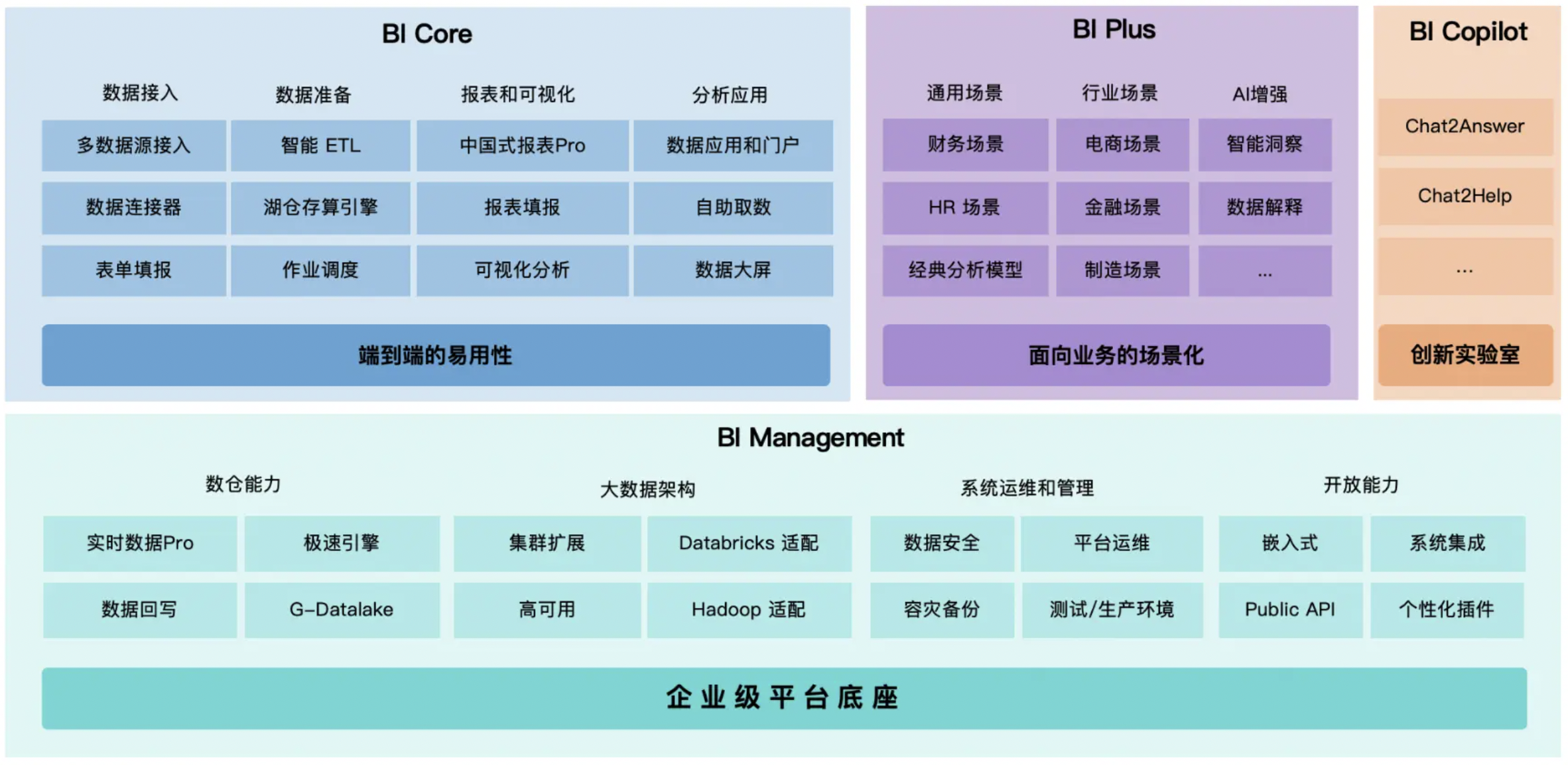
2. Enterprise Pain Points
2.1 In the VUCA Era, Enterprises Need to Be More Agile Than Ever
The VUCA era is an emerging modern term representing an era full of volatility, uncertainty, complexity, and ambiguity. The world is facing unprecedented changes. Global pandemic outbreaks, complex geopolitics, rising inflation, and supply chain shocks have all brought tremendous pressure and complexity to enterprises.
In this turbulent historical context, enterprises face unprecedented challenges. The relatively stable, predictable, and normalized development path of the past has been broken. Enterprises need to make correct business decisions quickly in a rapidly changing market environment. During the pandemic, many enterprises failed to respond to market changes in time, losing development opportunities and even facing bankruptcy. However, the VUCA era also contains opportunities. Although the environment is complex, it also means market changes are more frequent, with new business models and opportunities constantly emerging. Enterprises can actively respond to challenges through digital transformation, discovering and seizing deterministic growth opportunities. Therefore, how to embrace changes and seize new growth breakthroughs, how to simplify complexity and find operational certainty, and how to successfully achieve digital transformation have become inevitable common challenges for enterprises.
2.2 Data Productivity That Can't Keep Up with the Pace, Inefficient BI That Hinders Decision-Making
From the perspective of data lifecycle and enterprise collaboration, there are various problems in the data system regarding enterprise data governance. First, enterprises have numerous information systems, leading to scattered and isolated data. Leaders of different functional departments have different focus points on decision-making information needs, making it difficult to ensure consistency and accuracy in data usage. Additionally, over-reliance on manual data statistics by personnel leads to severely lagging data statistics, with heavy workloads and high error rates. Such reports have very limited value after in-depth analysis.
Second, the process of report development and data analysis after data extraction is cumbersome. The main pattern involves business departments submitting requirements to data analysis teams, who then organize requirements and submit them to IT departments for response on a weekly or monthly basis, producing relatively fixed analysis reports. This cumbersome process means that business personnel who just want to simply view some data need to go through multiple steps, waiting for scheduling and development completion. For data analysis teams, they should focus on deep business analysis and value definition, but they are often bound by tedious work such as data extraction and table creation, becoming "data extractors" and "report makers."
Behind each report lies complex processes such as data extraction, ETL development, scheduling, and storage. Report development and production are IT-led because traditional BI has high technical barriers and operational difficulty, requiring professional personnel to complete data analysis. Most business personnel cannot independently use and analyze data. Meanwhile, the application results of traditional BI are mainly data reports, making it difficult to achieve deep data mining and insights. Due to independent requirements between different business departments, upstream data will be consumed N times by downstream businesses, leading to overlapping and inconsistent reports, with a large number of duplicate dormant reports. Such duplicate development wastes IT development resources while also occupying BI system computing performance and storage space. Additionally, due to slow report requirement response, data analysis cannot keep up with real-time changes in business development. In many cases, reports that have just been developed may already be outdated, seriously hindering the timeliness of business decision-making. In summary, these issues are all very important challenges in enterprise analysis and decision-making.
2.3 Building Complex Business Analysis Models, Enterprises Have the Will but Lack the Ability
In the era of information explosion and the deepening promotion of enterprise digital transformation, high-timeliness decision-making scenarios have fully erupted, becoming key to enterprise development. However, traditional BI construction shows a series of drawbacks in this fast-paced environment, such as long project deployment cycles, low IT team development efficiency, and inflexible analysis. To adapt to this trend, enterprises not only need to rely on mature and easy-to-use BI products but also need to quickly build analysis indicators and models suitable for themselves by combining deep understanding of industry attributes and vertical business scenarios. However, enterprise business problems are usually very complex, involving cross-analysis of multiple dimensions and indicators. Traditional data analysis tools often cannot meet this complexity. Solving this problem requires professional data analysis tools combined with data experts' professional analysis thinking.
Enterprises are facing more refined and efficient business operation needs. BI is not just data analysis; it is an important part of data-driven decision-making. Only when strongly bound to real business can data value be maximized and truly solve actual enterprise needs.
For large enterprises, they may have rich data analysis experience and support from professional technical teams, possessing rich experience in data viewing and analysis skills. However, when facing explosive data growth and constantly changing business needs, responding to high-timeliness decision-making scenarios remains a challenge. For small and medium-sized enterprises or enterprises with insufficient data analysis experience, how to quickly achieve industry best practices at the lowest cost, how to view data with an analyst's perspective and understand data, how to quickly produce conclusions in massive analysis panels, and how to provide more data value to provide quality data consumption experience for management and business teams, with minimal resource investment in scenario-based construction, has become the goal that every enterprise expects.
2.4 Unable to Meet Enterprise Scale, Digital Transformation Becomes Empty Talk
With the continuous growth of enterprise business scale, every tool and every business line will generate massive amounts of data, even reaching single-table billion-level or total data volume PB-level scale. Traditional BI and data warehouses cannot meet the storage and analysis needs of large-scale data, often experiencing performance bottlenecks such as slow data query response and slow computing processing speed. Generating a data analysis report takes half a day. Meanwhile, complex system integration and compatibility situations test both IT teams and enterprise-level applications' technical support for scaled business development. Traditional BI architecture is relatively old and single, difficult to adapt to rapid data changes and dynamic scalability needs. Additionally, when enterprise user numbers increase, high-performance, high-concurrency, high-stability, and high-security enterprise-level capabilities also become essential. To address these challenges, modern BI often leverages distributed computing capabilities from big data and cloud-native technologies to meet real-time processing and analysis of massive data. Elastic scaling enables BI systems to maintain effective resource utilization and stable operation under different data loads and business scenarios, with unlimited elastic expansion to adapt to enterprise future needs of billions, trillions, or even trillions of data.
2.5 Using Fragmented Products Will Seriously Hinder Business Decision-Making Efficiency
In the most common business analysis decision-making scenarios, various departments and different roles need to collaborate, from raw sales data to final business insights and decisions. This process includes data warehouse development, report design, and visual analysis needs. However, if different tools and platforms are used for each step, a series of problems will arise.
Fragmented multi-tools and platforms mean more complex data flow links, higher data quality risks and governance difficulty, and longer development and launch cycles. From the perspective of upper-level business users, multiple tools will give the entire data chain higher learning and usage barriers, requiring additional training costs, and facing greater collaboration pressure during use. From the perspective of lower-level business operations, multi-system deployment and operations, account and permission management, and system integration make the management difficulty and complexity of data-driven business increase dramatically. The above issues may all become obstacles on the enterprise digital transformation path. Using isolated tools will lead to information synchronization problems, reduced business processing capabilities, and significantly increased costs in data migration, operations management, and other aspects.
Overall, fragmented products and tools usually lead to decreased business decision-making efficiency, resulting in a 1+1<2 effect, thus constraining overall business development. Therefore, integrating data and analysis tools, improving collaborative cooperation and data circulation, and significantly improving business decision-making capabilities and efficiency are not only problems that enterprises truly expect to solve but also key to successful digital transformation.
3. What Solutions Does Guandata BI Provide?
Based on the above various pain points, we believe that modern BI can only "make business use it" and leverage 10X-100X business user agile decision-making, ultimately promoting enterprise organizational agile decision-making and even agile digital transformation, after possessing the core characteristics of ease of use, enterprise-level, scenario-based, and one-stop.
-
BI needs to lower the full-chain threshold of data analysis, making business quickly use it and achieve low-threshold decision-making;
-
BI needs to adapt to business scenarios and changes, making business actively use it and achieve deep decision-making;
-
BI needs to have future-oriented extensibility, making business widely use it and achieve distributed decision-making;
-
BI needs to support the complete decision-making chain of enterprises, possessing integrated capabilities to achieve complete decision-making;
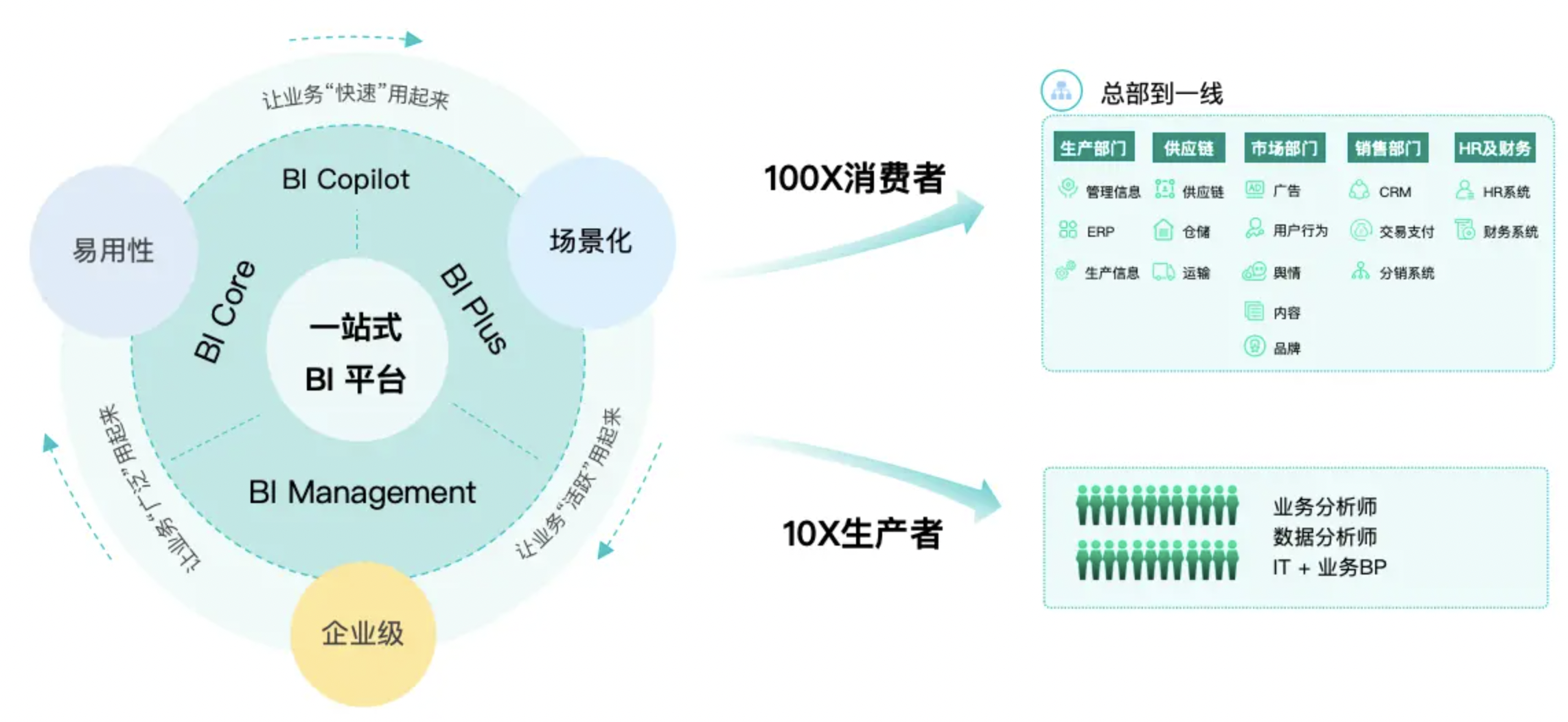
4. How Does Guandata BI Implement Based on These Ideas?
Guandata BI is a one-stop BI platform composed of a series of product matrix combinations, such as zero-code drag-and-drop ETL development tool - Smart ETL; scenario-based applications that accumulate industry best practices - scenario packages, intelligent insight applications, etc.; Chinese-style report functions highly compatible with Excel; cool visual components for one-click installation and one-click data entry to solve temporary data source integration problems, etc. It meets the ease of use for business to quickly use it, scenario-based features for business to actively use it, and enterprise-level capabilities for business to widely use it.
In the actual implementation process, BI product forms also need to have "one-stop" characteristics. For this reason, Guandata has built a one-stop BI platform that better conforms to business habits and addresses integration needs. Taking the most common business analysis decision-making scenario as an example, from raw data such as sales data aggregated into data analysis models, to financial reports and business analysis dashboards, and then to generated analysis insights and business decisions, this entire series of processes involves various roles and differentiated behaviors of various departments in the enterprise organization. From the perspective of this decision-making scenario chain, it involves four main scenario needs: data warehouse needs, report needs, analysis needs, and AI needs. This modern BI platform considering integrated business helps enterprises achieve higher efficiency and higher quality business decision-making levels at minimum cost, improving the overall competitiveness and innovation capabilities of enterprises.
4.1 Making Business "Quickly" Use It - Ease of Use
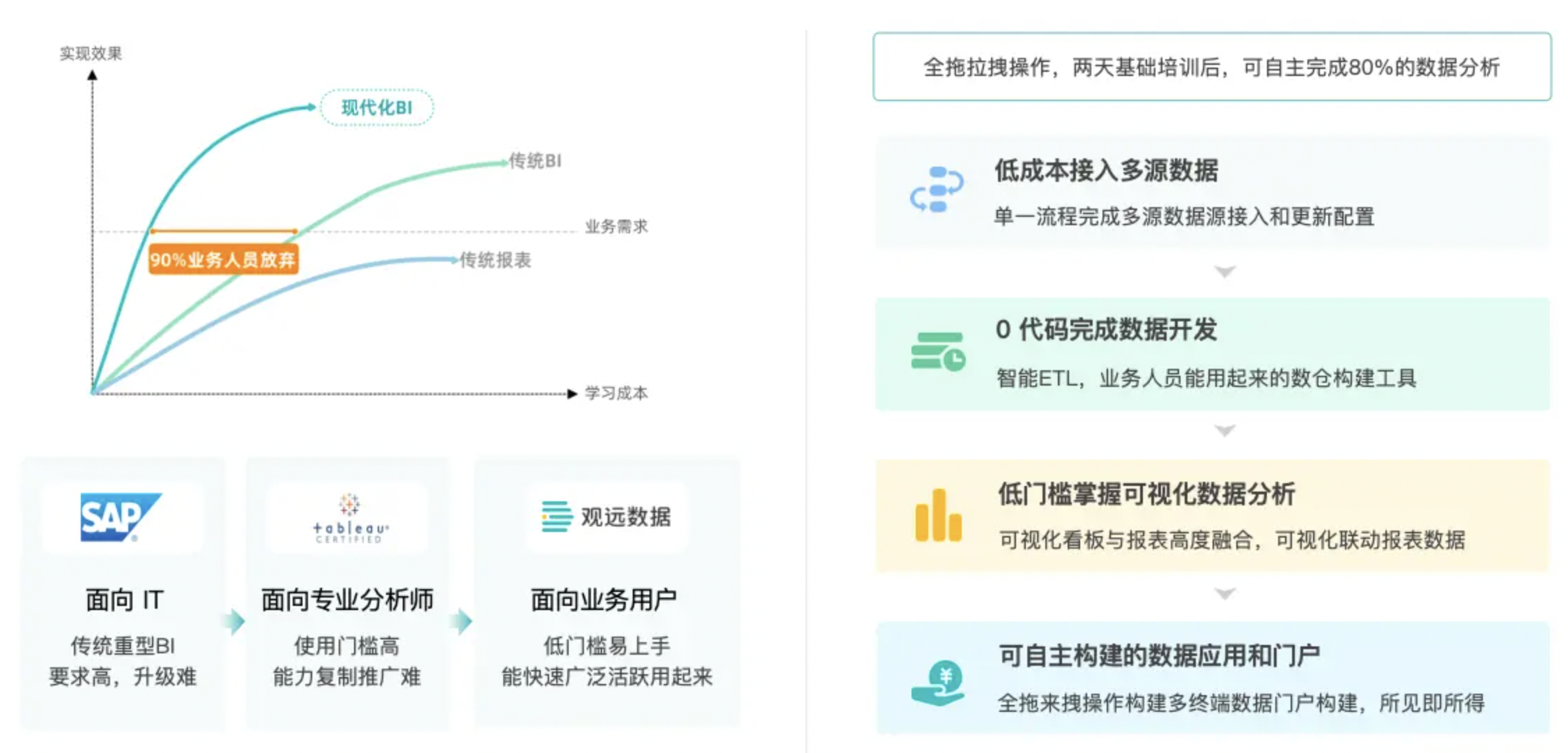
Guandata adopts a unique "990" product design methodology, committed to improving work efficiency by 10 times for 90% of business personnel compared to traditional BI in 90% of typical business scenarios. Guandata focuses on ease-of-use design, enabling business personnel without technical backgrounds to easily get started and quickly leverage BI's powerful functions to achieve more agile data analysis and decision-making. Ease of use is not limited to a specific functional point, nor is it simply drag-and-drop operations, but rather enabling business personnel to enjoy end-to-end overall ease of use, such as more efficient Smart ETL development for efficiency multiplication in data preparation, visual analysis supporting batch quick operations, intelligent attribution and automatic conclusion report generation for data insights, etc., truly achieving user ease of use from data integration to data consumption across the entire chain.
For example, in the data preparation stage, Guandata's Smart ETL is a zero-code efficient data processing tool with real-time preview functionality, helping users correct data in time, supporting multiple reuse of calculation logic and multi-point output, and other features. This enables non-technical personnel who don't understand SQL to complete professional work such as data preparation and data warehouse construction through drag-and-drop, configuration, and self-service business methods, reducing data governance difficulty.
On the other hand, in the data analysis stage, Guandata has created a "highly Excel user habit compatible" low-threshold, one-stop complex report. This report deeply integrates with BI visual analysis, making complex data easy to understand and present. By integrating highly compatible Excel with BI, the data processing chain becomes shorter, and traditional manual reports are quickly converted to online reports. This significantly simplifies operational costs and complexity, making report development more agile, and complex reports are no longer "complex."
Data consumption is the process of effectively reaching "data consumers" after integrating visualized data content. If BI is about transforming massive data into actionable insights, then mobile BI is about pushing the initiative of data analysis and decision-making to users' eyes, no longer limited to specific devices or fixed locations. Through multi-terminal applications such as PC self-service analysis, mobile H5, mobile light applications, data portals (PC + mobile), and data screens, the zero-code self-built feature throughout the process meets both diverse business scenario needs and business department needs for quick production/timely distribution. To further enhance data tracking and active reach effects, Guandata also integrates third-party platforms such as DingTalk and WeChat Work to achieve data following people, thus easily achieving the effect of "planning within the tent, winning battles thousands of miles away."
4.2 Making Business "Actively" Use It - Scenario-Based
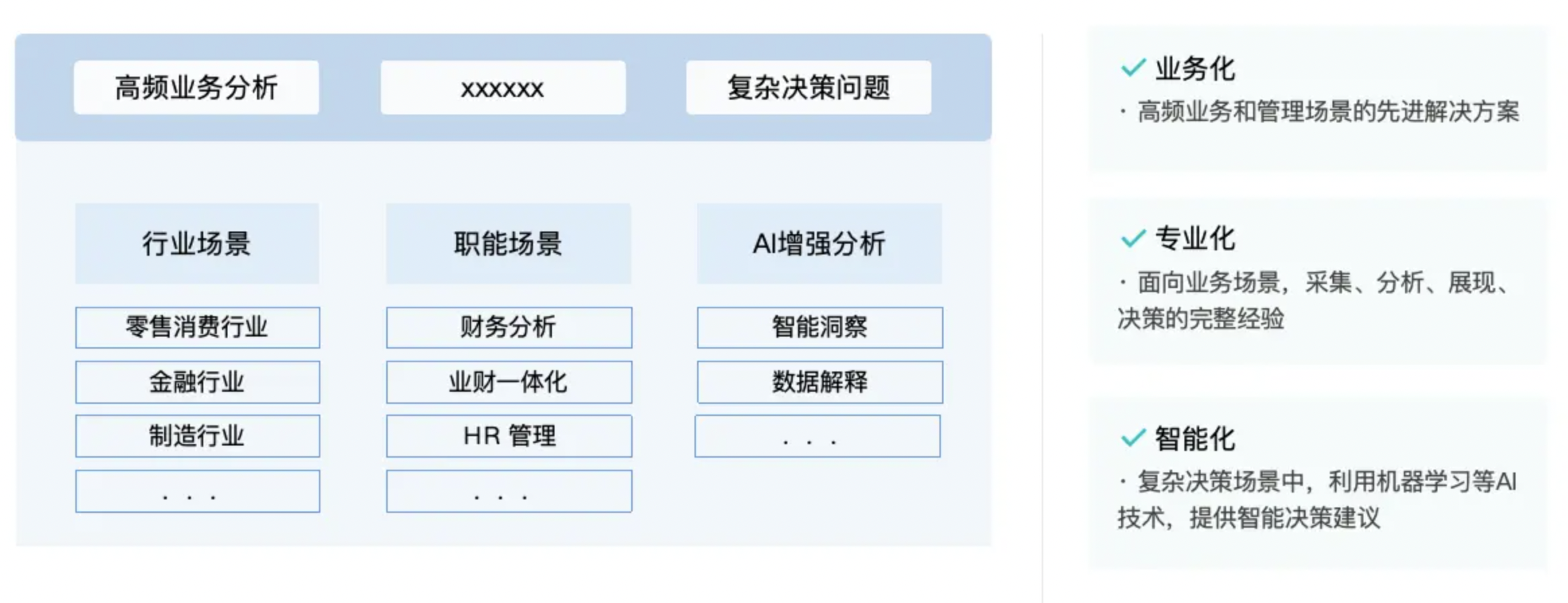
Based on accumulated experience from industry best practices in retail, FMCG, finance, pan-internet, central state-owned enterprises, and other industries, Guandata provides advanced solutions for high-frequency scenarios such as enterprise revenue analysis, financial cost control, and supply chain planning, helping enterprises build data analysis and decision-making systems faster, more comprehensively, and more prospectively. To make business actively use it, we provide complete data application chains covering data collection, analysis, presentation, and decision-making for business scenarios, based on极致易用的用户体验, restoring business scenarios from a business perspective, and creating scenario-based applications that meet business demands.
Additionally, Guandata binds AI-enhanced analysis with real business scenarios, combining analyst thinking to deeply mine enterprise data value by settling down to business. It provides "data insight" capabilities starting from automatically generating report conclusions, periodically tracking changes in core business indicators, while multi-dimensionally decomposing abnormal reasons and deducing business strategy changes. Through the "data following people" approach, it reduces the analysis pressure on data teams, improves the data viewing efficiency of business teams, and enables enterprises to focus more energy on business innovation.
We package typical enterprise data analysis scenarios as "plug-and-play scenario-based analysis suites" for enterprises to use. We hope that enterprises in various industries at different digital development stages can quickly implement data application and analysis capabilities required by business at minimum cost, and in various analysis scenarios, more users can quickly understand data from a professional analyst's perspective, accelerating response to market and enterprise problems, truly making business "actively" use it.
4.3 Making Business "Widely" Use It - Enterprise-Level
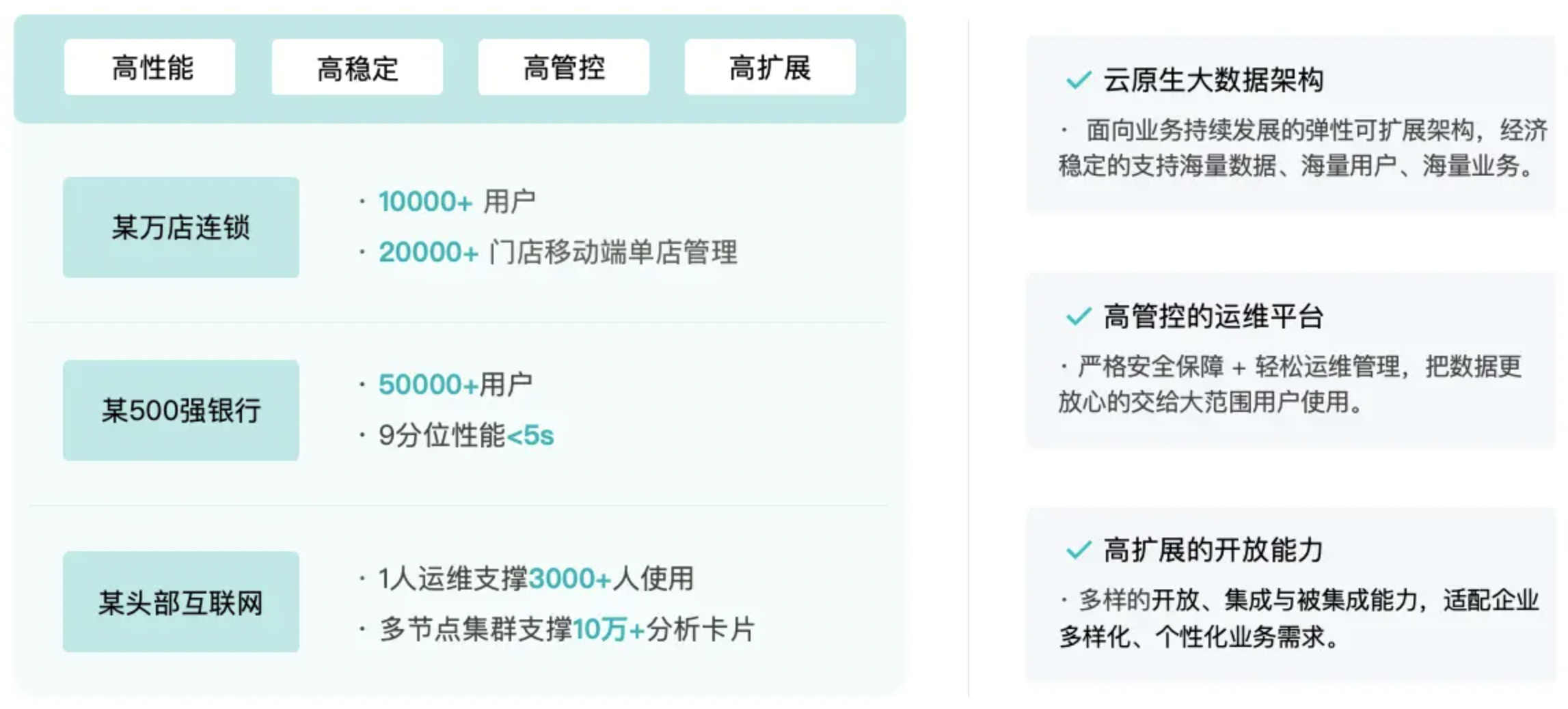
Guandata takes high openness, high extensibility, and high performance as core principles, follows scientific layered design principles, combines the latest development technologies for research and iteration, and creates a one-stop intelligent analysis platform with high efficiency, strong stability, and极致体验 for users. Technically, it adopts Spark+Delta Lake big data architecture, giving the product excellent data computing performance and horizontal scaling capabilities, thereby providing powerful data and algorithm support for business, with evolutionary strategies helping enterprise data personnel transition seamlessly. Meanwhile, integrating ClickHouse's acceleration capabilities with the product can one-click convert Guan-Index datasets and ETL datasets to high-performance query tables, achieving query and analysis acceleration. Additionally, Guandata can deeply integrate with Hadoop big data platforms, delegating computing and storage management to Hadoop, fully leveraging Hadoop platform's own capabilities. For enterprise-level deployment scenarios, leveraging Hadoop's high availability, high scalability, high fault tolerance, and other advantages to build a truly business-available enterprise-level big data analysis platform.
The integration of big data + cloud-native enables BI to adapt to unlimited enterprise business extension. Beyond that, Guandata also supports providing enterprise business personalization and business integration capabilities (such as open API interfaces, plugin productization, etc.), performing page embedding, function calls, data upload/download, external trigger updates, etc., according to flexible business scenarios, bringing open collaborative effects to enterprises.
As the saying goes, three parts construction, seven parts operations. As BI deeply integrates into enterprise business processes, operational support becomes particularly important. Traditional passive operational investment often yields half the results with double the effort, with difficulty in discovery, difficulty in troubleshooting, and post-incident emergency firefighting being the norm. Guandata focuses on BI cluster resources, business usage, data asset governance, and other aspects, forming a proactive intelligent operations health assessment steward that regularly outputs visual inspection reports for user interpretation. It helps enterprises proactively master platform status, discover abnormal risks in time, predict risks in advance, and provide governance ideas and action suggestions. This way, it both reduces daily operational work costs and further ensures continuous stable and efficient system operation. From this, we can see that Guandata BI provides efficient empowerment for enterprises in multiple scenarios such as high-performance response under large-scale data, continuous service under large-scale operations, and efficient platform governance under large-scale business, supporting business to "widely" use it.
4.4 Complete Business Decision-Making Chain - One-Stop
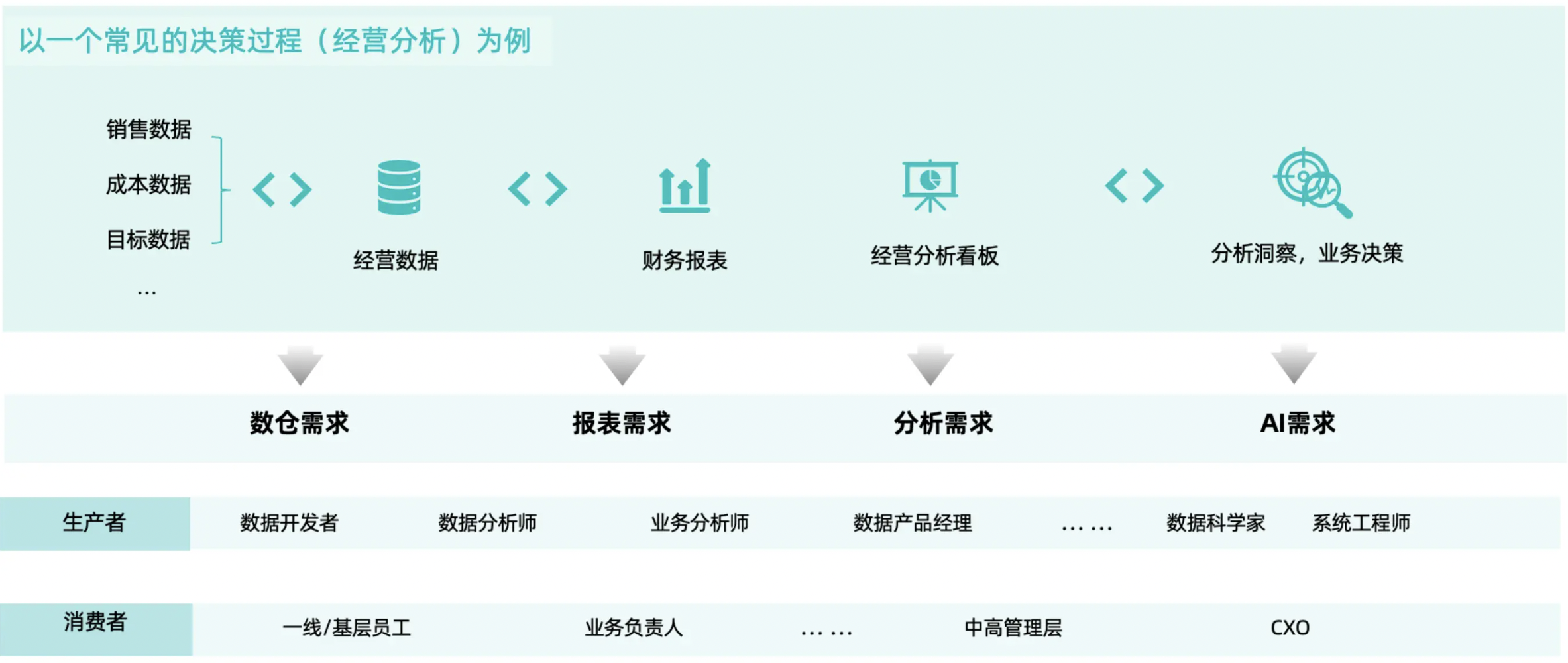
Facing explosive data growth and data application challenges, enterprises are facing severe challenges in achieving true data value and promoting long-term sustainable business growth. Guandata believes that establishing full-chain data analysis and decision-making capabilities is the best way to solve this data challenge. Guandata's BI products have always adhered to the "one-stop" concept, integrating key capabilities on different business decision-making chains, enabling users at various levels of enterprises to participate according to their roles and needs, obtaining required data support and data insights from each other.
Taking the most common business analysis decision-making scenario as an example, from raw data such as sales data aggregated into data analysis models, to financial reports and business analysis dashboards, and then to generated analysis insights and business decisions, this entire series of processes involves various roles and differentiated behaviors of various departments in the enterprise organization. From the perspective of this decision-making scenario chain, it involves four main scenario needs: data warehouse needs, report needs, analysis needs, and AI needs. This modern BI platform considering integrated business helps enterprises achieve higher efficiency and higher quality business decision-making levels at minimum cost, improving the overall competitiveness and innovation capabilities of enterprises.
Fragmented products will make information synchronization difficult and weaken business processing capabilities, thereby reducing business decision-making efficiency and constraining overall business development. However, Guandata BI platform's one-stop solution covers the complete closed-loop chain from data integration, data preparation, analysis and visualization, to diversified data applications, meeting the key needs of the above four decision-making chains, accelerating agile decision-making processes, truly achieving data's commercial value and promoting sustainable business development.